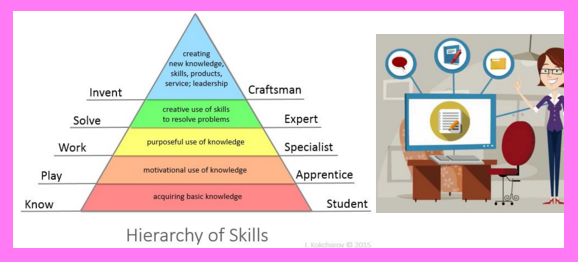


- Identify Desired End Results:
- study standards and learning goals
- identify learning goals and desired enduring understandings
- prioritize learning goals
- Determine Acceptable Evidence:
- determine what evidence we will accept to show that students have achieved mastery of goal
- Plan Learning Experiences and Instruction:
- what foundational skills will students need to reach goals?
- purposefully design and analyze learning tasks: how will formative assessments be used to develop student learning? what tasks will help students develop a deep understanding of learning goals?
- Avoid common errors (see pitfalls above)
-
Analyze nouns in standards and connect these big ideas
-
Identify key knowledge and skills in standard
-
What essential questions follow from standard?
-
Analyze verbs and connect these to performance assmts
-
List learning activities
- Refine unit to insure alignment across all phases
-
Clarify larger purposes and connections between applications and content.
-
Identify specific real world tasks that embody goals
-
Determine enabling knowledge & skills needed for tasks
-
Sketch learning plan that enables practice to mastery
-
Infer questions learners need to frequently consider as they learn
- Identify content standards that explicitly tie to tasks
- Revise to align design elements as needed
-
What complex worthy task does this skill support? How does this skill connect to other relevant skills?
-
Identify related content standards
-
Determine what assessments are implied or explicit in standard
-
Identify strategies for using skills effectively
-
Identify big ideas and essential questions that undergird the skill
-
Devise learning activities.
- Revise for alignment.
-
Start with winning activity or sanctioned resource
-
Consider: Why does this activity matter? What big ideas does this activity help us understand?
-
Clarify essential questions that will point to these big ideas
-
Identify the skills, facts, and understandings the activity is meant to yield
- Tie activity to relevant standards and infer key concepts and skills in these
- Revise assessments and learning activities as needed.
-
Clarify goals and levels of transferability built into assessment
-
Identify standards that address these goals
-
Infer relevant big ideas, understandings, essential questions required to pass assessment
-
Develop and refine performance assessment tasks that parallel the required assessment
-
Craft and modify learning activities to ensure effective and purposeful performance.
- Revise to align design elements as needed
-
Place elements into template and look for alignment across 3 phases. Do the goals match the assessments?
-
Do lessons relate to richest aspects of goals?
-
Clarify big ideas and long term performance goals related to standards
-
Ask often: What should students come away understanding?
-
Revise assessments and lessons to do justice to Stage 1 elements
- Revise to align design elements as needed


- Develop a Year at a Glance (Scope & Sequence)
- Prioritize standards in scope and sequence
- Use one of the strategies above to develop a project that goes with a unit cluster of standards
- Use Understanding by Design template and related standards to guide and evaluate project development
- Use design criteria to evaluate project elements as they are implemented in project
- Document evaluations of projects and extract generalizable tips and ideas that can be applied to future project designs
- Use the multiple entry point models to help students design their own investigations and projects


It’s really beautiful work. Thanks for this kind of stuff. I mean I am totally impressed. Hope to see more updated work here. I have to say, it is very informative.
Cloud Hosting